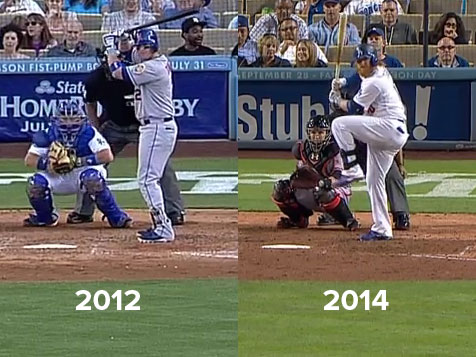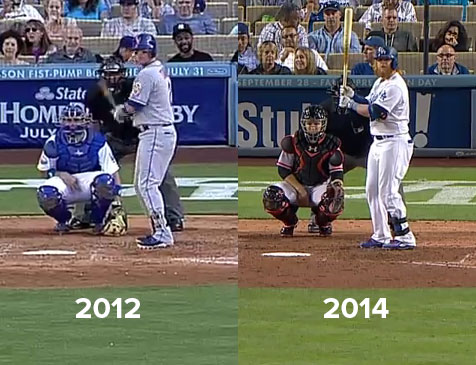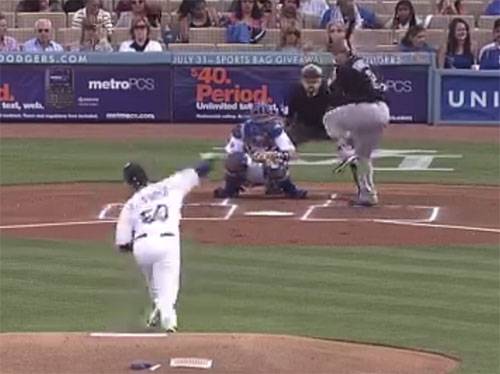Of all the ways the Mets could Met, this one has been the most beneficial to all of us: They non-tendered Justin Turner last winter, slammed his “hustle,” then watched him blossom into a vital part of a Dodgers team with championship aspirations and single-handedly outperform most of the 2014 New York offense. Mets gonna Mets, as they say, and this one has so many different lolMETS angles built into it.
Of course, the flip side to that: If you really and honestly predicted that Turner was going to do this, you wouldn’t receive credit for your baseball acumen. You’d be removed from the population. You would be a crazy person. There was absolutely no way to see this coming.
So I keep asking myself, well, how is this happening? This first answer is easy: Helllllooooo, BABIP. Turner’s rolling a .397 BABIP out there, which is not only easily the highest of his career, it’s the second-highest of any player with 300 plate appearances. It’s one of the ten highest BABIP seasons this century, which we are now 15 (!) seasons into, because time keeps going on and can’t be stopped. Any discussion of Turner’s success has to start with that, because it’s the one thing that really stands out so clearly. When he’s not as good next season — and he won’t be — this is where you’re going to look. That doesn’t mean that he can’t be great over the remainder of 2014, because you can never pinpoint the date where regression is going to happen, but it does mean that if you’re expecting a repeat in 2015, you’ll be disappointed.
So there’s that, but simply saying “it’s luck” is both unsatisfying and unfair to the player. However, Turner doesn’t make it easy on us by having any of his batting peripherals really pop out in such an extreme way. I’ve seen some talk of “it’s his first time getting regular playing time,” but that’s not true, because he had 487 plate appearances in 2011, a number he won’t come close to this year. “It’s because he’s an LA native happier playing at home” is another, and I won’t rule out some validity to that, but it’s both unprovable and impossible to believe that it’s changed him this much.
How about his peripherals? He’s not striking out less. Actually, he’s striking out more, with an 18.4% whiff rate that’s going to be an easy career worst. He’s walking more if you compare it to last year — 8.6% to 5.1% — but he also had an 8.0% walk rate in 2011, when he had all that playing time, and it didn’t turn out like this.
His batted ball rates aren’t much different, either. He’s hitting 48.7% grounders; for his career, it’s 48.3%. He’s at 27.9% fly balls; his career is 28.6%. He’s certainly got a much higher HR/FB rate, but with only seven homers, that’s not really based on a lot, either.
Better plate discipline? Hard to see much there. Turner’s 2014 swing rate is 45.5%. His career swing rate is 45.5%. Understandably, he’s not really changed his usual rate of swinging inside and outside the zone. If there’s anything that stands out here, it’s things that shouldn’t be good. His Z-Contact% (contact when swinging at pitches in the zone) is down four percent from last year. His O-Contact% (contact when swinging at pitches outside the zone) is up three percent. That’s generally a terrible sign. For years, my response to people who hailed Juan Pierre‘s ability to avoid strikeouts was “yeah, but he’d make contact on terrible pitches and ground out weakly.” Turner is making contact with more “bad” pitches. It’s working for him. I have no idea.
Improved strength leading to better distance? The numbers say no, because this year he’s getting 284.86 feet on his average fly ball. Last year it was 283.82.
So far, this isn’t great. I’m trying desperately to find an explanation for Turner that isn’t BABIP, and we’re coming up empty. Here’s the one thing I did find: His stance is different.
What follows is a series of four pictures, split into two sections. The first two show Turner’s pre-pitch stance, one from 2012 with the Mets, and one from last night. (They’re both from Dodger Stadium, against lefties — Clayton Kershaw in 2012, Madison Bumgarner last night — to try to keep the camera angle consistent.)
So there, finally is a difference: That big red beard! It’s clearly the source of his power. Oh, and also he’s got a much more open stance. That too.
The second two are continuations of the same pitches, showing his leg kick, or lack of it.

I realize now that the way I cropped these, you can’t really tell that the pitcher is about to deliver the pitch. My fault, there, but I’m not redoing them, you’ll have to trust me on it. Turner now has a huge leg kick, where he used to stand relatively still. Now we’re getting somewhere! A change we can point to! Mystery solved! You can go on with your day, knowing that…
…oh lord, here he is in Dodger Stadium in 2011:
Apologies for the blurriness of that image, but you get the idea. He had the kick before, too. This isn’t necessarily new. Like many hitters, he’s tweaked his approach over the years.
I’d like to say I had a smoking gun to point to here that explains Turner’s success. I really, truly don’t, and that’s a little frustrating. It doesn’t mean that we can’t enjoy what he’s provided, because we absolutely should. He’s been huge when Juan Uribe has been injured, he’s been a nice counterpoint to have to Dee Gordon, and he’s also existed at shortstop. You can have all the megabillions contracts you want, but sometimes you do need a nice surprise like this to kick in to. I can’t tell you why it’s happened, but it’s happened, and it’s been great to watch. Good on you, Justin Turner. Glad to have you.
Now, about that BABIP…
 Dodgers Digest Los Angeles Dodgers Baseball Blog
Dodgers Digest Los Angeles Dodgers Baseball Blog

